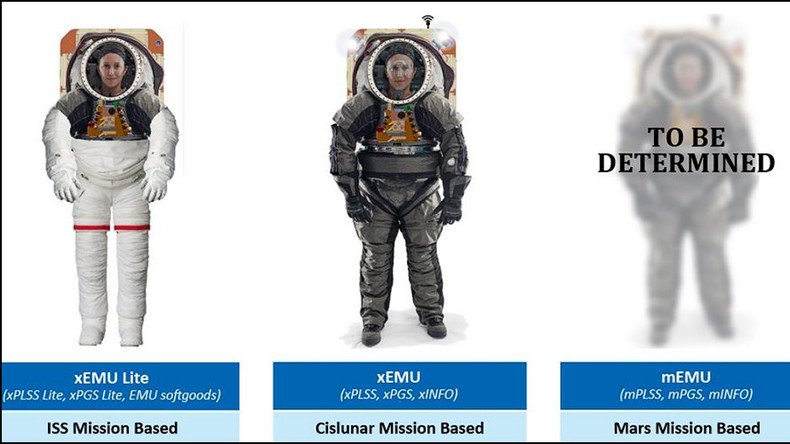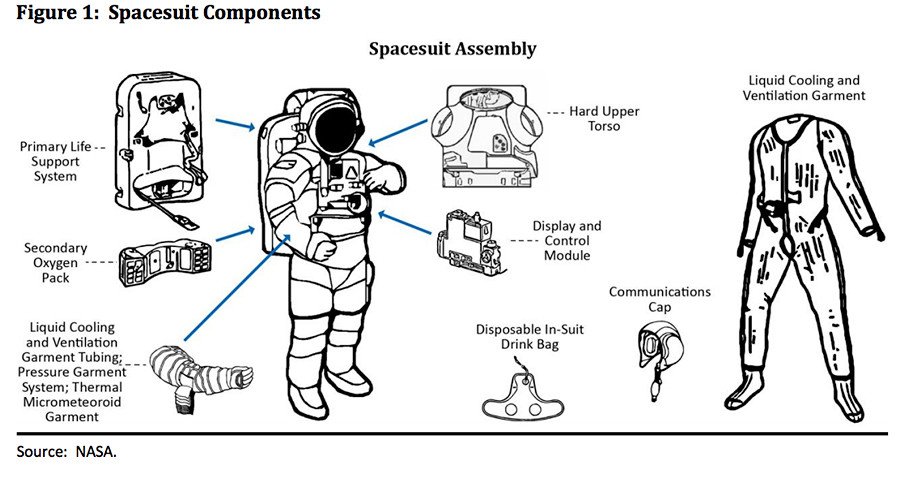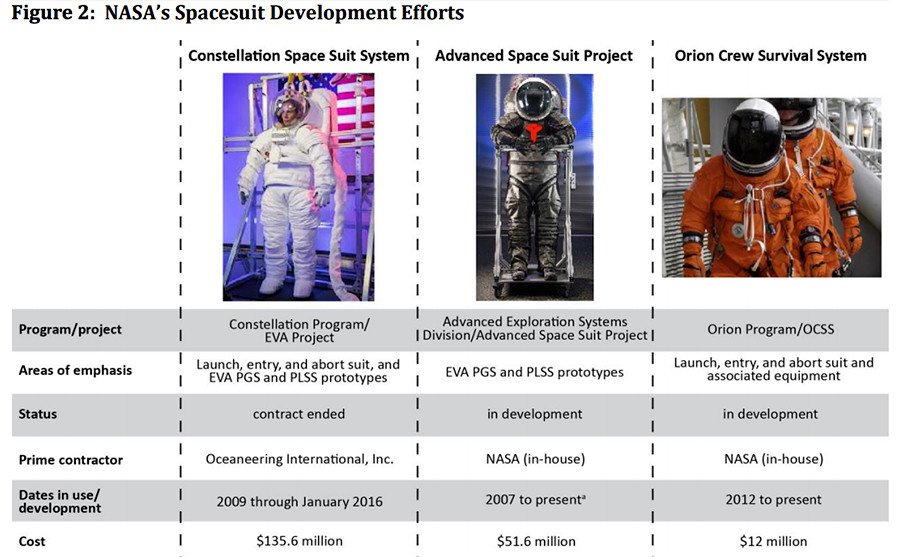NASA next gen spacesuits not ready before Intl Space Station retires – audit

NASA spent nearly $200 million on three new spacesuit designs for deep space exploration, although only one of the suits will be ready for testing on the International Space Station (ISS) before it retires in 2024, according to an audit by the agency.
“Despite this investment, the Agency [NASA] remains years away from having a flight-ready spacesuit capable of replacing the [current spacesuit] or suitable for…future exploration missions,” stated the report, which was released on April 26.
Among the three design projects, auditors were critical of NASA spending $148 million on the Constellation Space Suit System (CSSS) program, which began with a contract issued to Oceaneering International to develop a suit for the Constellation exploration program in 2009.

A year later, the Obama administration canceled the project but NASA kept the contract active until January 2016, spending an additional $80.6 million on developing portions of the spacesuit technology, according to the audit.
NASA said it continued the contract because it wanted to keep the industry engaged in spacesuit design. Auditors dismissed this argument, however, noting the agency’s in-house projects shared several contractors and primary subcontractors with Oceaneering.
.@NASA's space agency is running out of spacesuits. https://t.co/7exdV96NOtpic.twitter.com/AIcwxN9Ghb
— Vocativ (@vocativ) April 27, 2017
The report found that by extending the program it duplicated work on another spacesuit design, the Advance Space Suit Project (ASSP). Designs for the ASSP were more advanced than the CSSS, but the auditors found NASA spent three times as much on the latter’s design.
Auditors found the ASSP had weaknesses including the lack of defined destinations for exploration missions, which affected the suit design, as well as “competing funding priorities” leading to the project only being financed for half a year in 2016.
The ASSP was redirected to a spacesuit design known as Exploration EMU, or xEMU, which will be tested on the ISS, but not until 2023.
“This schedule leaves only one year for testing before the Station’s planned 2024 retirement,” the report stated, but added that “extending the ISS operations beyond 2024 would alleviate this schedule pressure.”
Nasa is running out of spacesuits and urgently needs new ones, agency reveals - The Independent https://t.co/y37ILBiyzX#Newspic.twitter.com/BFH9v8t1Cx
— News JS Namibia (@newsjsNA) April 27, 2017
A third program, the Orion Crew Survival Suit, a pressure suit designed for use on the Orion spacecraft, is also facing delays, with the suit on track to be available only five months before the current launch date for the first crewed Orion mission in August 2021.
The audit was issued the same week President Donald Trump placed an inter-orbital call to NASA astronaut Peggy Whitson to congratulate her on setting a record for time spent in space and expressed his own goals for Mars.
“Tell me,” he asked. “For Mars, what do you see as a timing for actually sending people to Mars? Is there a schedule, and when do you see that happening?”
In reply, Whitson told the president that NASA could go to Mars by the 2030s.
“Unfortunately spaceflight takes a lot of time and money,” she said. “Getting there will require some international cooperation, a planet-wide approach in order to make it successful just because it is a very expensive endeavor.”
Space call: Trump congratulates record-setting NASA astronaut Peggy Whitson https://t.co/yTeDfF7R5Fpic.twitter.com/dZiyN87hyb
— RT (@RT_com) April 24, 2017
“Well, we want to try and do it during my first term or, at worst, during my second term,” Trump responded. “So we’ll have to speed that up a little bit, okay?”
Trump has already proposed cutting NASA’s budget by about 1 percent in fiscal year 2018.

Auditors recommended the agency create a plan for developing a next-generation spacesuit and conduct a trade study comparing maintaining the current EMU spacesuits versus developing a new one, and apply lessons learned from existing spacesuit efforts to new designs.
NASA accepted the recommendations and said it would have a spacesuit development plan completed by the end of September, although its chief of human spaceflight, William Gerstenmaier, argued the report was “overly critical” and disagreed with the auditors findings over the work with Oceaneering.
NASA astronauts currently use spacesuits called ExtraVehicular Mobility Units, originally designed 40 years ago. The EMUs have been redesigned and completely refurbished multiple times since then. The space agency concluded its design life could last until 2028, but it would not meet the agency’s needs for deep space exploration.
The space agency only has 11 of the original 18 EMU units left for future operations. They are also ill-suited to exploring planetary surfaces because they lack the hip flexibility needed to walk.












